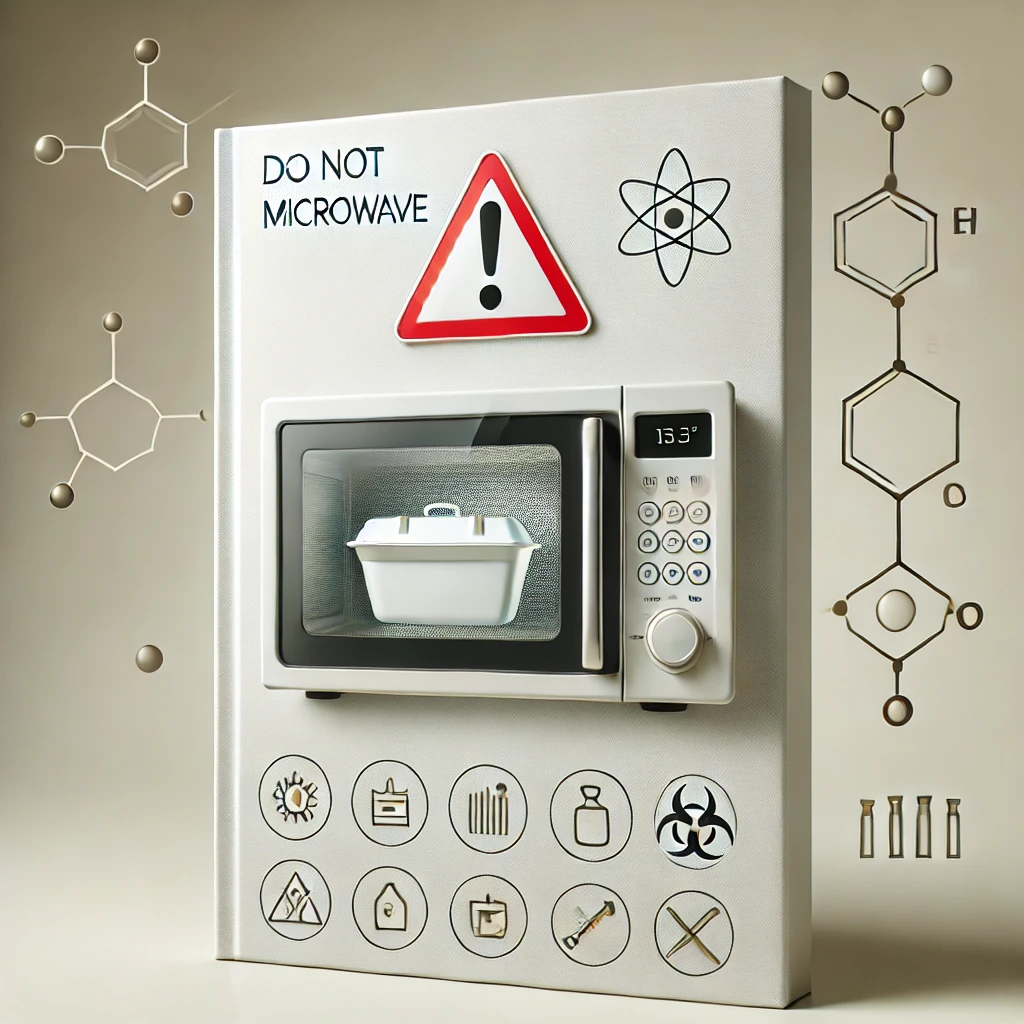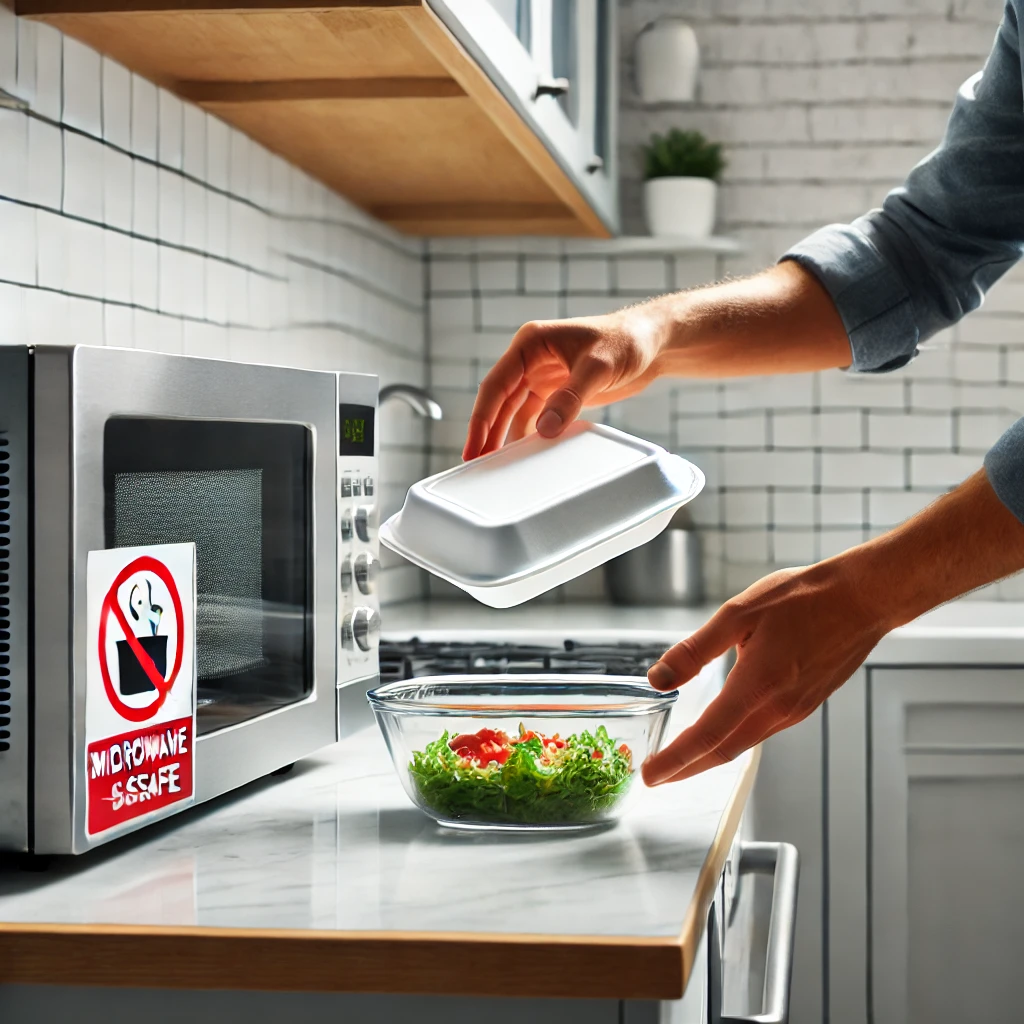This post may include affiliate links which means I may receive a commission from purchases made through links. I will only recommend products I have personally used. Learn more on my private policy page.

We’ve all been there: leftovers in a Styrofoam container, the convenience of the microwave just a few feet away, and the thought, “Is it safe to microwave Styrofoam?” before pressing start.
Microwaving food in Styrofoam seems like a harmless shortcut, but what does science say about it?
In this post, we’ll break down the safety of microwaving Styrofoam and uncover the risks, health concerns, and safe practices you need to know.
Let’s dive into what the experts have to say!
What is Styrofoam?
First things first: what exactly is Styrofoam?
Known by its technical name polystyrene foam, Styrofoam is a lightweight plastic material that’s commonly used in food containers, coffee cups, and packaging.
Its popularity is largely due to its ability to insulate heat, making it great for keeping hot foods warm and cold drinks cool.
Despite its widespread use, Styrofoam has come under scrutiny, especially when it comes to heating it.
While it’s cost-effective and convenient, not all Styrofoam products are created equal, and that plays a huge role in answering the question: can you microwave Styrofoam?
Can You Microwave Styrofoam?
The short answer is: It depends on the type of Styrofoam.
If you’ve ever noticed the “microwave-safe” symbol on some Styrofoam containers, it’s because certain types of Styrofoam are designed to withstand the microwave’s heat.
These containers have undergone testing to ensure they won’t melt, warp, or release harmful chemicals when heated.
On the other hand, regular Styrofoam—the kind used in disposable coffee cups and takeout containers—is not designed to be microwaved.
When exposed to the heat of a microwave, these products can melt or break down, releasing chemicals into your food.
Health Risks of Microwaving Styrofoam
When it comes to microwaving Styrofoam, the potential health risks go beyond just a melted mess in your microwave.
Regular Styrofoam, which is not labeled as microwave-safe, can release harmful chemicals when exposed to the high temperatures of a microwave.
These chemicals can seep into your food, posing a range of health concerns that are important to understand. Let’s dive deeper into the risks associated with microwaving Styrofoam.
1. Release of Harmful Chemicals
Styrofoam, or polystyrene foam, contains a chemical compound called styrene, which is used in the production of various plastic materials.
When Styrofoam is heated, especially at the high temperatures generated by microwaves, it can start to break down.
This breakdown can lead to the release of volatile chemicals like styrene into the food it’s in contact with.
Styrene is a cause for concern because exposure to high levels of styrene has been linked to a range of health issues, including respiratory problems and irritation of the eyes, nose, and skin.
When ingested, these chemicals may be absorbed by the body and could potentially build up over time.
Although short-term exposure to small amounts of styrene from a single instance of microwaving is unlikely to cause immediate harm, repeated exposure could be more problematic.
2. Styrene and Cancer Concerns
One of the biggest concerns surrounding styrene is its potential link to cancer. The National Toxicology Program and International Agency for Research on Cancer (IARC) classify styrene as a possible human carcinogen.
While research is ongoing, studies in animals have shown that high levels of styrene exposure can lead to cancer, and there is growing concern about the long-term effects of even low-level exposure in humans.
When microwaving non-microwave-safe Styrofoam, you run the risk of releasing small amounts of styrene into your food.
While the levels may not be immediately harmful, cumulative exposure over time—especially if you frequently reheat food in Styrofoam—could pose a long-term risk.
3. Endocrine Disruption
Styrene is also considered to be an endocrine disruptor, meaning it can interfere with the body’s hormone systems.
Endocrine disruptors mimic or block the action of hormones in the body, leading to a variety of health problems, especially when exposure occurs over time.
Disruptions to the endocrine system can lead to a range of issues, including:
- Reproductive problems: Hormone imbalances can affect fertility and reproductive health in both men and women.
- Developmental issues: Exposure to endocrine disruptors can have harmful effects during pregnancy, potentially impacting the development of the fetus.
- Metabolic and immune disorders: Prolonged exposure can increase the risk of conditions such as diabetes, obesity, and immune dysfunction.
Although the exposure to styrene through microwaving Styrofoam is generally low, the concern is that even low-dose exposure over time can add up and lead to more serious health problems, especially when combined with exposure to other environmental toxins.
4. Plasticizers and Additives
In addition to styrene, Styrofoam may also contain other plasticizers and chemical additives that are used to improve its strength, flexibility, and heat resistance.
These additives can also leach into food when heated, especially in fatty or acidic foods, which tend to absorb more chemicals.
Some of these chemicals, like phthalates, are also considered endocrine disruptors and may contribute to health issues such as:
- Increased cancer risk
- Obesity and metabolic disorders
- Neurodevelopmental issues in children
The breakdown of Styrofoam during microwaving can result in a chemical cocktail that could have far-reaching effects on human health, especially with repeated exposure over time.
5. Contamination and Food Quality
Beyond chemical contamination, microwaving Styrofoam can also affect the overall quality and safety of your food.
When Styrofoam begins to melt or warp under heat, it can transfer microplastics into your food.
Microplastics have been shown to accumulate in the body, potentially leading to long-term health issues, including inflammation and disruptions to the immune system.
While research is still ongoing, microplastics are increasingly being recognized as a potential health hazard.
Additionally, melting Styrofoam can lead to physical contamination of your food.
Ingesting small bits of plastic, while not immediately dangerous, can pose choking hazards or cause digestive issues, especially in children or pets who might be exposed to improperly heated food.
6. FDA Regulations and What It Means for You
While the FDA does allow certain types of Styrofoam to be labeled as microwave-safe, it’s important to note that regular Styrofoam containers are not designed to be heated.
Microwave-safe Styrofoam has been manufactured to withstand the higher temperatures without breaking down or releasing harmful chemicals.
However, even microwave-safe Styrofoam containers should be used with caution.
These products are usually safe for short-term heating at low temperatures, but overheating or prolonged exposure can still cause degradation and release harmful compounds into your food.
This is especially true for fatty or oily foods, which tend to heat unevenly and reach higher temperatures more quickly.
Should You Microwave Styrofoam?

In conclusion, the health risks of microwaving Styrofoam stem from the release of harmful chemicals like styrene, as well as the potential for endocrine disruption, cancer concerns, and plastic contamination in food.
Although some Styrofoam containers are deemed safe for microwave use, it’s always best to err on the side of caution and transfer your food to a glass or ceramic container before reheating.
By doing so, you’ll reduce your exposure to harmful chemicals and protect both your health and the environment.
What Science Says About Its Safety
Now, what does science really say about microwaving Styrofoam?
The U.S. Food and Drug Administration (FDA) does approve certain types of Styrofoam for microwave use, but these containers are specially manufactured to be heat-resistant.
Polystyrene, the material Styrofoam is made of, starts to soften at temperatures around 212°F (100°C).
Since microwaves heat food unevenly, parts of the Styrofoam container could reach temperatures high enough to start degrading, releasing volatile compounds like styrene.
Research suggests that microwave-safe Styrofoam does not release harmful amounts of chemicals when used correctly.
However, regular Styrofoam should never be microwaved.
The breakdown of polystyrene at higher temperatures can cause contamination in food and poses a safety risk.
How to Microwave Safely (If at All)
Microwaving Styrofoam can be a risky endeavor if not done carefully.
While some Styrofoam containers are labeled as microwave-safe, many are not, and the potential for harmful chemicals to leach into your food or the container to melt is a real concern.
However, if you find yourself in a situation where you must microwave food in a Styrofoam container, following safe practices can minimize your risk.
Here’s how to microwave safely, if at all:
1. Check for Microwave-Safe Labels
Before microwaving anything in Styrofoam, the first and most important step is to check for a microwave-safe label.
This label indicates that the container has undergone testing and is designed to withstand microwave heat without releasing harmful chemicals or degrading.
The FDA regulates microwave-safe products, meaning containers that carry this label are considered safe for typical microwave use.
However, even these containers should be used with care, as high temperatures or prolonged heating can still cause problems.
- Where to Look: The microwave-safe symbol can usually be found on the bottom of the container or printed on the packaging. It often appears as a microwave icon or may include words like “microwave-safe.”
- What to Avoid: If there’s no label or the container is not marked as microwave-safe, it’s best to assume that the Styrofoam is not safe for use in the microwave.
2. Transfer Food to a Safe Container

When in doubt, the safest option is always to transfer your food to a microwave-safe glass or ceramic container.
Glass and ceramics are both heat-resistant materials that can handle the high temperatures of microwaving without breaking down or leaching chemicals.
- Microwave-Safe Materials: Look for containers labeled microwave-safe, such as Pyrex or heat-resistant glass, which are ideal for microwaving food safely.
- Avoid Plastics: Some plastic containers, unless labeled microwave-safe, may also leach chemicals when heated, so they should generally be avoided as well.
Not only does this practice eliminate the risk of Styrofoam contamination, but it also ensures that your food heats evenly and safely.
Plus, using glass or ceramic dishes can help maintain the taste and quality of your food without any risk of plastic-like odors or chemical tastes.
3. Heat in Short Intervals
If you must microwave food in a microwave-safe Styrofoam container, heat in short intervals to prevent the container from overheating.
Styrofoam can withstand short bursts of heat better than prolonged exposure, which can cause it to soften, melt, or release harmful substances.
- Heat in 30-60 second bursts: Instead of microwaving food for several minutes at once, start with shorter intervals and check the food in between to see if it’s adequately heated.
- Stir the food between heating intervals: This ensures more even heating and prevents hot spots from forming, which can cause parts of the Styrofoam container to overheat and degrade.
- Monitor the container closely: If you notice any warping, softening, or melting of the Styrofoam, stop microwaving immediately and transfer the food to a safer container.
4. Avoid Greasy or Oily Foods
One of the reasons microwaving Styrofoam can be problematic is that greasy or oily foods tend to heat up much faster than other types of food.
This is because fats absorb microwave energy more quickly, often reaching higher temperatures than the Styrofoam can handle.
- Why It’s Risky: High-fat foods like butter, oils, and fried foods can cause Styrofoam containers to overheat and break down more quickly.
- When Styrofoam begins to melt, it not only makes a mess but also poses a risk of chemical leaching into your food.
- What to Do Instead: If you’re heating greasy or fatty foods, it’s especially important to transfer them to a microwave-safe glass or ceramic dish before microwaving to prevent any issues.
5. Don’t Reuse Disposable Styrofoam
Even if you successfully microwave food in a Styrofoam container once, don’t reuse the container for future microwaving.
Disposable Styrofoam containers are not meant for multiple uses, and repeated microwaving can increase the risk of the container breaking down.
- Single-use only: Styrofoam containers, especially those from takeout or restaurant packaging, are designed for single use only.
- The more a Styrofoam container is heated, the more likely it is to deteriorate, increasing the chances of harmful chemicals being released.
- Long-term safety: Reusing disposable Styrofoam in the microwave could lead to increased chemical exposure over time, which, as noted earlier, could pose health risks.
6. Be Cautious with Hot Liquids
If you’re microwaving beverages like coffee or soup in a Styrofoam cup, even one labeled as microwave-safe, use caution.
Hot liquids can heat Styrofoam unevenly and cause the container to weaken, which increases the likelihood of chemicals leaching into the liquid.
- Use microwave-safe mugs instead: For hot beverages, it’s best to transfer them to a microwave-safe mug or glass before heating.
- Styrofoam cups are generally not designed for prolonged heating of hot liquids, even if they don’t immediately melt.
7. Consider Safer Alternatives
If you regularly reheat food in the microwave, it’s a good idea to invest in safer, more durable alternatives to Styrofoam.
While Styrofoam is convenient for takeout and single-use packaging, it’s not the safest option for microwaving.
- Glass containers: Glass is one of the best materials for microwave use as it is non-reactive, meaning it won’t leach chemicals into your food, even at high temperatures.
- Ceramic containers: Like glass, ceramic is heat-resistant and safe for use in the microwave. Many ceramic containers are designed specifically for microwaving and can handle high heat without breaking down.
- Microwave-safe plastic: While some plastic containers are not suitable for microwaving, many are labeled as microwave-safe and can be a convenient option for reheating food.
Additionally, using reusable containers helps reduce waste and is better for the environment compared to single-use Styrofoam products.
Err on the Side of Caution
In conclusion, microwaving Styrofoam can be risky, and while microwave-safe Styrofoam containers exist, it’s best to use them sparingly and with caution.
When in doubt, transfer your food to a microwave-safe container, such as glass or ceramic, to avoid potential health risks and the mess of melted Styrofoam.
By following these guidelines, you can minimize your exposure to harmful chemicals, prevent contamination, and keep your kitchen safe.
Environmental Concerns of Styrofoam

Aside from personal health risks, Styrofoam poses significant environmental challenges.
It’s non-biodegradable and takes hundreds of years to break down in landfills.
Microwaving Styrofoam contributes to the release of microplastics, which can enter the environment and harm wildlife.
There are eco-friendly alternatives like biodegradable packaging, reusable containers, and microwave-safe silicone products that reduce environmental impact while keeping your kitchen safe.
The Bottom Line on Microwaving Styrofoam
In summary, the question “Can you microwave Styrofoam?” depends on a number of factors.
Microwave-safe Styrofoam is designed to withstand heat and can be safely microwaved according to FDA standards.
However, regular Styrofoam should never be microwaved due to the risk of releasing harmful chemicals like styrene.
The bottom line?
When in doubt, transfer your food to a microwave-safe container to avoid health risks and keep both you and the environment safer.
Now that you know what science says about microwaving Styrofoam, you can make informed decisions for your health and your kitchen.
FAQs
Q: What are the consequences of accidentally microwaving Styrofoam?
A: If it’s not microwave-safe Styrofoam, it may melt or release harmful chemicals into your food.
If this happens, it’s best to discard the food and container.
Q: How can I tell if my Styrofoam is microwave-safe?
A: Look for a microwave-safe symbol or a label stating it is safe for use in the microwave.
If there is no label, assume it’s not safe.
Q: Are there safer alternatives to Styrofoam?
A: Yes!
Opt for microwave-safe glass, ceramic, or silicone containers for safer heating.



